Key takeaways
- OPEC’s primary goal is to stabilize oil markets by balancing production levels, influenced by geopolitical tensions and national interests.
- Global oil pricing is complex, affected by benchmarks, futures markets, and currency exchange rates, showcasing the vulnerability of prices to speculation and political events.
- Political dynamics significantly impact oil prices, with crises often elevating prices due to supply fears and strategic use of oil as leverage in negotiations.
- OPEC’s effectiveness can fluctuate based on member unity; successes like the 2016 production cut demonstrate their capacity to stabilize markets, while internal discord risks market confidence.
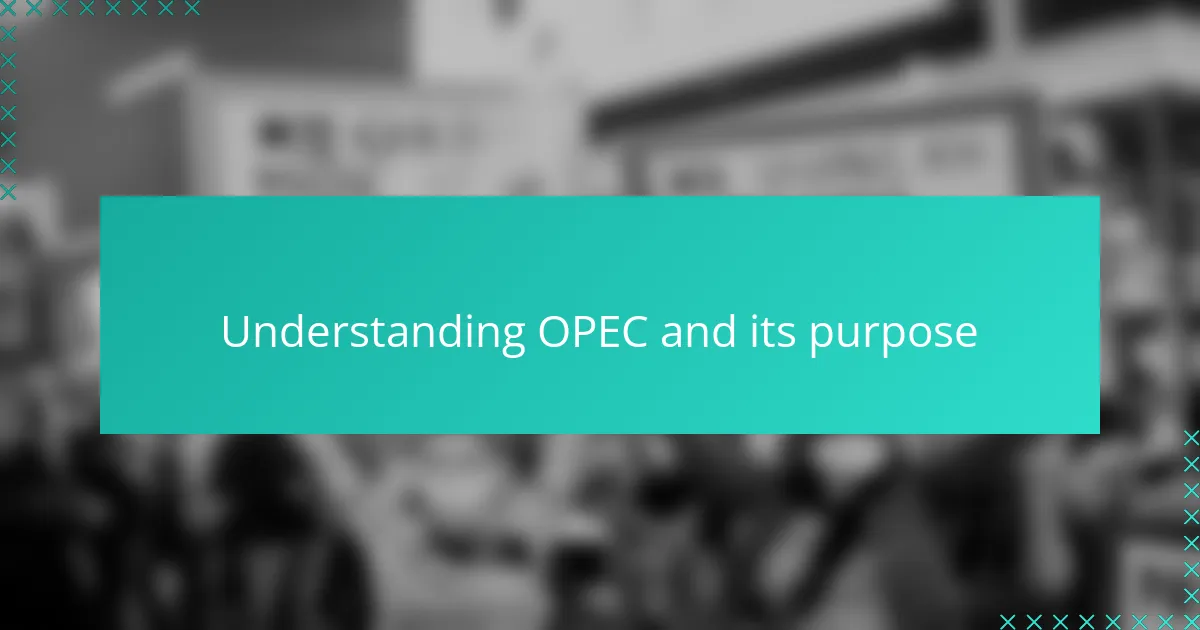
Understanding OPEC and its purpose
When I first looked into OPEC, I was struck by how it’s more than just a group of oil-producing countries coordinating output. To me, it feels like an intriguing balance of cooperation and competition, where national interests shape not just economies but global energy landscapes. Have you ever wondered how these nations decide when to pump more oil or hold back? That decision shapes prices worldwide, affecting everything from your gas tank to international politics.
What really caught my attention is OPEC’s foundational purpose: to stabilize oil markets. It’s fascinating because stability sounds straightforward, but in practice, it’s a complex dance influenced by fluctuating demand, geopolitical tensions, and economic pressures. I’ve seen how this effort to avoid extreme price swings can sometimes feel like walking a tightrope, especially when member countries have differing priorities.
Understanding OPEC’s role made me realize it’s not just about oil; it’s about control and influence. The organization aims to secure fair returns for producers, but it also wields power in the global political arena. This dual function makes OPEC a unique player, and it challenges me to think more critically about how energy resources intersect with diplomacy and economic strategy.
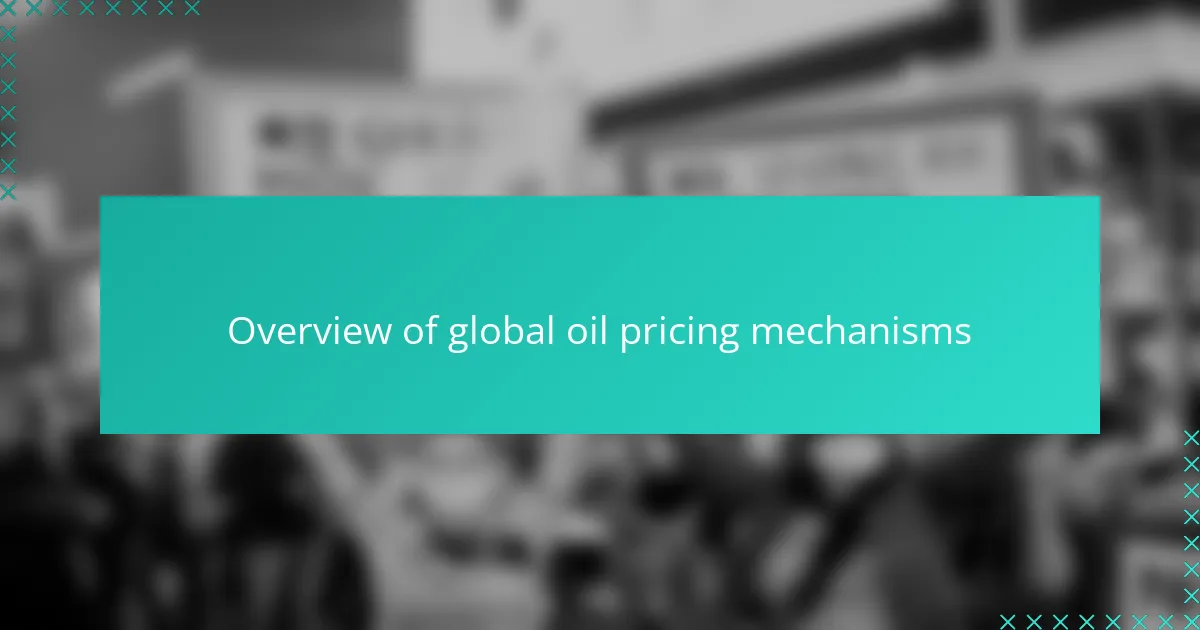
Overview of global oil pricing mechanisms
When I first tried to grasp how global oil prices are set, I realized it’s not a simple matter of supply and demand. Oil pricing involves complex mechanisms that include benchmarks like Brent and WTI, which act as reference points for contracts worldwide. These benchmarks feel like the pulse of the industry, reflecting market sentiment at any moment.
What really made me pause is how futures markets come into play—prices today aren’t just about what’s happening right now but also what traders expect in the future. It struck me how much speculation can drive prices, sometimes more than actual physical supply or demand. Have you ever considered that a single tweet or political event can ripple through these markets, shifting prices in seconds?
Lastly, I found that currency exchange rates and geopolitical risks weave into this pricing web in intricate ways. For instance, since oil is priced in U.S. dollars, fluctuations in the dollar’s value directly impact global oil costs. This interplay made me appreciate how vulnerable oil prices are to global financial and political shifts, adding yet another layer of complexity to a system that at first seemed straightforward.
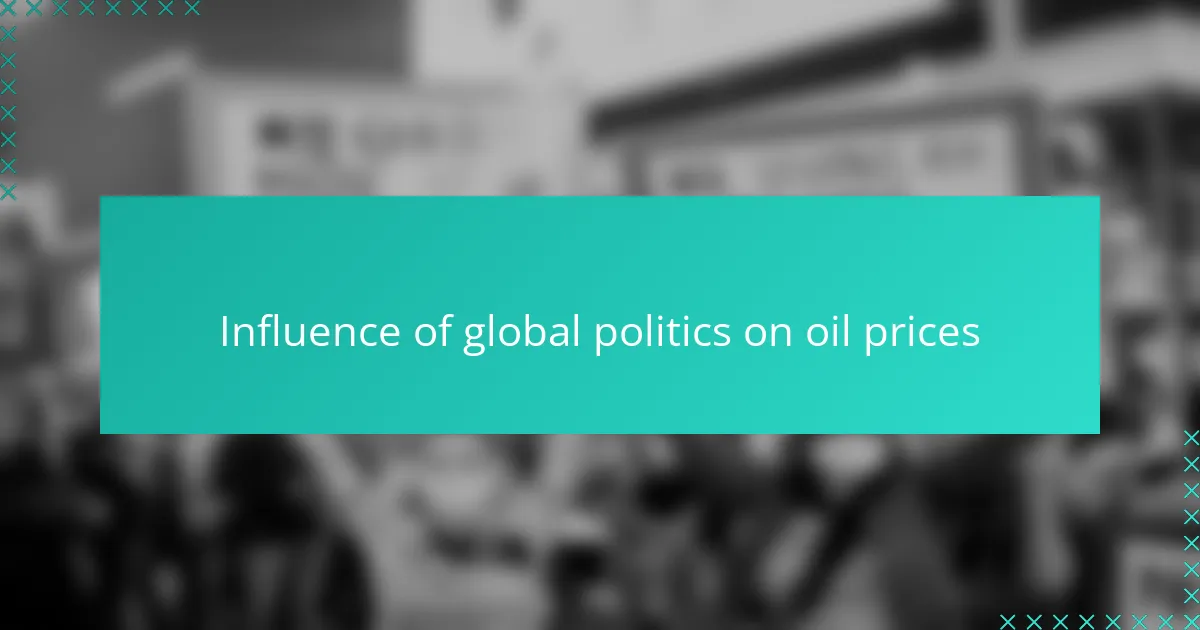
Influence of global politics on oil prices
I’ve often noticed how political events—like sanctions, conflicts, or diplomatic talks—send immediate shockwaves through the oil markets. It’s almost like watching a live drama where each headline suddenly makes the price charts jump or dive. Have you ever seen how a geopolitical crisis can tighten supply fears, pushing prices higher almost overnight? I find it both fascinating and unsettling how fragile the balance is.
At times, I wondered why oil prices don’t always move with pure economics but seem to respond more to political posturing. This makes sense when you consider that oil is a strategic commodity, a tool for influence beyond just commerce. When countries use oil as leverage in negotiations or conflicts, prices reflect the underlying power plays rather than just barrels being pumped or stored.
What really struck me is how global alliances and rivalries shape not just immediate costs but long-term expectations in the market. For example, an alliance that unexpectedly breaks or a new coalition forming to control supply can rewrite the rules almost instantly. Experiencing this taught me to look beyond numbers and charts and pay attention to political narratives—they often tell you more about where prices are heading than any data alone.
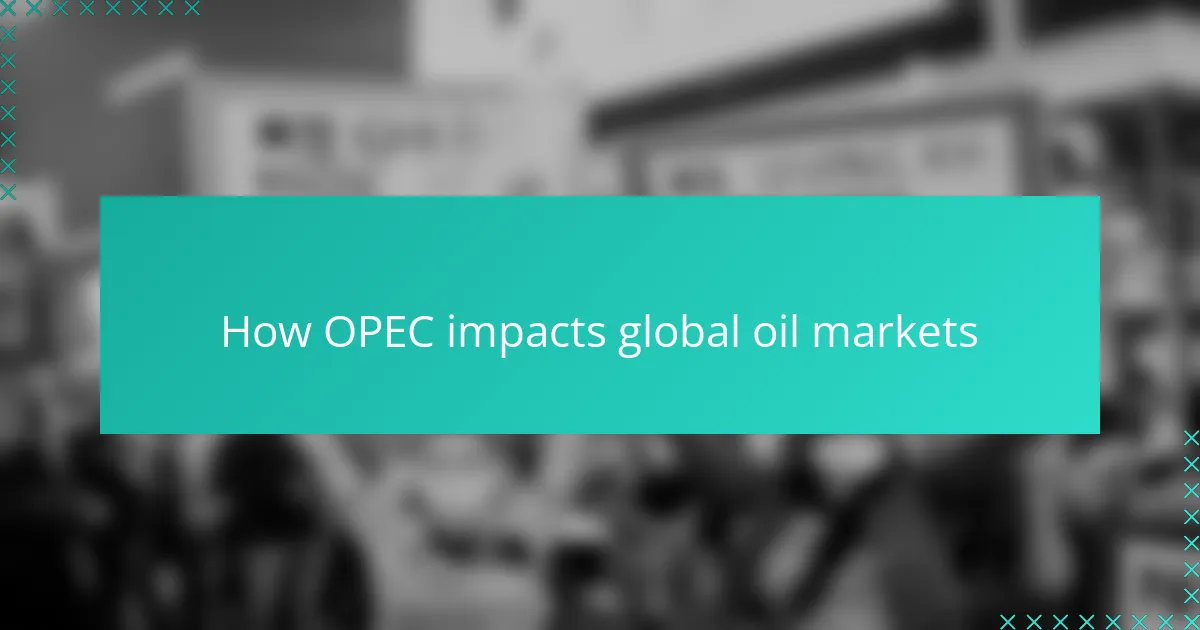
How OPEC impacts global oil markets
What really helped me grasp OPEC’s impact on global oil markets is seeing how its production decisions act like a global thermostat. When members agree to cut or boost output, it sends immediate signals to traders worldwide, nudging prices up or down. Isn’t it remarkable how a handful of countries can, in a way, set the price of something so vital to our daily lives?
I remember thinking about the delicate balancing act OPEC plays—trying to keep prices high enough to benefit producers but not so high that it stifles demand or encourages alternative energy. This tension often means their decisions ripple far beyond oil fields, affecting inflation, economic growth, and even political stability. Have you ever stopped to consider how these production choices are a form of subtle power play on the global stage?
What fascinated me most is how OPEC’s influence isn’t absolute but depends on its unity and cooperation. When members disagree or some produce outside agreed limits, market confidence wavers, and prices can swing unpredictably. From my perspective, this shows that OPEC’s strength lies not just in what it controls but in how reliably it can coordinate—a lesson in both economics and diplomacy.
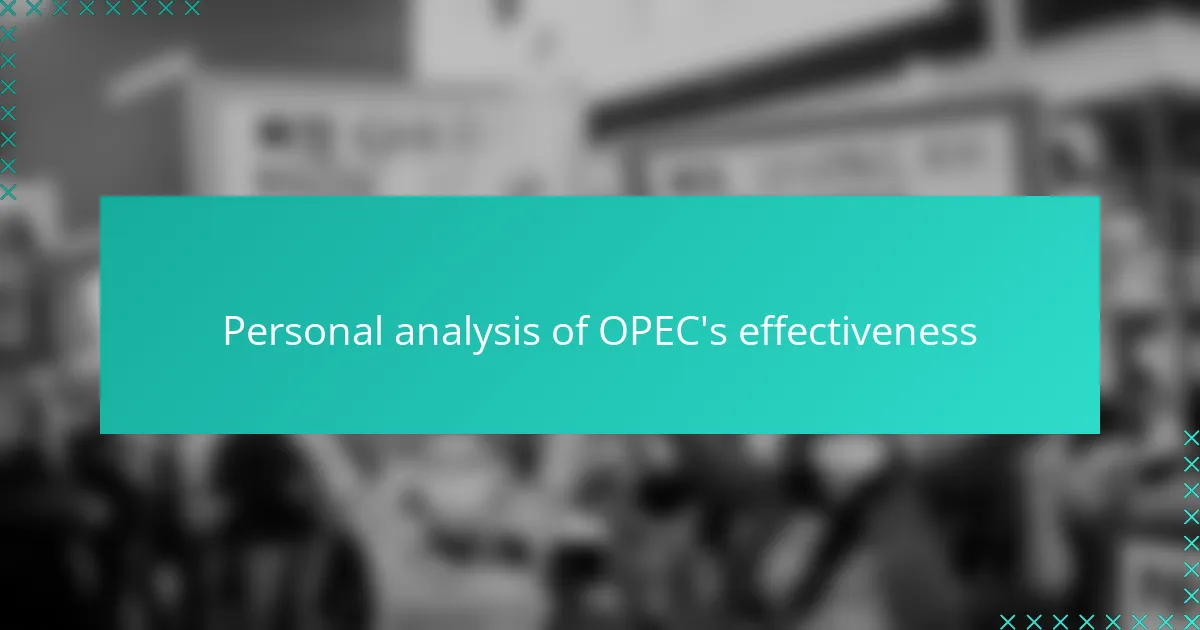
Personal analysis of OPEC’s effectiveness
I’ve often reflected on OPEC’s effectiveness and can’t help but notice that their influence feels like a double-edged sword. On one hand, when member countries align, the cartel seems almost like a conductor guiding a complex orchestra of oil supply. But when disagreements surface, it’s like the rhythm falters — and I’ve seen firsthand how that discord quickly shakes market confidence.
Sometimes I wonder if OPEC’s biggest challenge isn’t the external market pressures, but the internal balancing act between national interests. From my experience, it’s hard to maintain cohesion among countries with vastly different economic needs and political ambitions. This makes me question just how sustainable OPEC’s role really is when unity is so fragile.
What I find truly compelling is watching OPEC adapt—or sometimes struggle—to exert lasting control over oil prices amid shifting global dynamics. It often feels like they are playing catch-up with events outside their control, yet their decisions still ripple through the market powerfully. For me, this illustrates the organization’s paradox: influential yet vulnerable, commanding yet constrained.
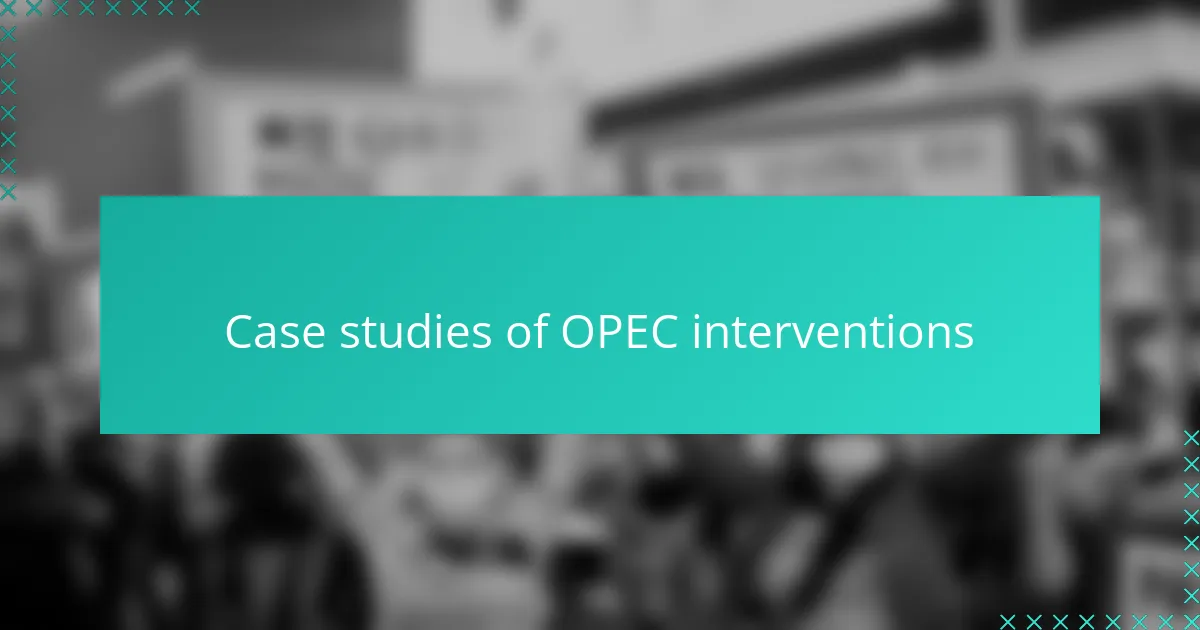
Case studies of OPEC interventions
When I looked closely at OPEC’s interventions, the 2016 decision to cut production stood out vividly. It was like watching a carefully choreographed move where major producers agreed to curb output after years of oversupply. I remember thinking how bold that was—because coordinating such a cut among diverse nations felt almost impossible, yet it managed to stabilize prices for a while. Have you noticed how that move temporarily rebalanced the market and boosted confidence?
Another moment that caught my attention was OPEC’s reaction to the 2020 oil demand crash amid the pandemic. Instead of stepping back, they struck a deep production cut with Russia, their key partner outside the cartel. To me, this was a striking example of OPEC’s evolving role—no longer just a club but part of a broader coalition aiming to manage extraordinary shocks. I found it fascinating how this strategic alliance helped prices recover despite unprecedented uncertainty.
Then there was the 2022 price surge linked to geopolitical tensions, where OPEC’s restraint in raising output seemed like a calculated gamble. I often wondered if this was a tactic to maintain leverage amid global instability. From my perspective, these case studies reveal OPEC’s interventions as both reactive and anticipatory moves—each one telling a story about how the cartel adapts to shifting pressures while trying to hold the reins on a turbulent market.
